Book contents
- Frontmatter
- Contents
- List of contributors
- Preface
- Part I Climate system science
- 1 The concept of climate sensitivity: history and development
- 2 Effect of black carbon on mid-troposphere and surface temperature trends
- 3 Evaluating the impacts of carbonaceous aerosols on clouds and climate
- 4 Probabilistic estimates of climate change: methods, assumptions and examples
- 5 The potential response of historical terrestrial carbon storage to changes in land use, atmospheric CO2, and climate
- 6 The albedo climate impacts of biomass and carbon plantations compared with the CO2 impact
- 7 Overshoot pathways to CO2 stabilization in a multi-gas context
- 8 Effects of air pollution control on climate: results from an integrated global system model
- Part II Impacts and adaptation
- Part III Mitigation of greenhouse gases
- Part IV Policy design and decisionmaking under uncertainty
- Index
- Plate section
- References
2 - Effect of black carbon on mid-troposphere and surface temperature trends
from Part I - Climate system science
Published online by Cambridge University Press: 06 December 2010
- Frontmatter
- Contents
- List of contributors
- Preface
- Part I Climate system science
- 1 The concept of climate sensitivity: history and development
- 2 Effect of black carbon on mid-troposphere and surface temperature trends
- 3 Evaluating the impacts of carbonaceous aerosols on clouds and climate
- 4 Probabilistic estimates of climate change: methods, assumptions and examples
- 5 The potential response of historical terrestrial carbon storage to changes in land use, atmospheric CO2, and climate
- 6 The albedo climate impacts of biomass and carbon plantations compared with the CO2 impact
- 7 Overshoot pathways to CO2 stabilization in a multi-gas context
- 8 Effects of air pollution control on climate: results from an integrated global system model
- Part II Impacts and adaptation
- Part III Mitigation of greenhouse gases
- Part IV Policy design and decisionmaking under uncertainty
- Index
- Plate section
- References
Summary
Introduction
There is a continuing controversy over whether satellite-observed temperature trends in the mid and lower troposphere based on Microwave Sounding Unit (MSU) satellite data since 1979 are consistent with surface-observed trends. The satellite trends are as much as 0.14 °C/decade smaller than the surface-observed trends. However, the satellite-inferred temperatures must be corrected for drifts and calibration differences between different satellites, and different procedures for doing so among different groups have led to different mid-tropospheric trend estimates. Here, we examine whether model-predicted trends are consistent with the satellite-based trends from the University of Alabama in Huntsville (UAH), and from the Remote Sensing Systems (RSS) group. It is important to re-examine model results in light of new evidence that indicates that the inclusion of black carbon aerosols tends to cool the surface and heat the troposphere, whereas the satellite data imply the opposite. Unlike previous model studies, we include an estimate of the effects of direct forcing by fossil fuel organic matter and black carbon aerosols, and by biomass aerosols, on trend estimates, as well as direct and indirect sulfate aerosol forcing, stratospheric ozone forcing and long-lived greenhouse gas forcing. We use the quasi-steady state results from the Commonwealth Scientific and Industrial Research Organisation (CSIRO) global climate model with a q-flux ocean model to correct transient simulations from the National Center for Atmospheric Research (NCAR) parallel climate model and from the CSIRO model that did not include the effects of fossil fuel carbon and biomass burning aerosols.
- Type
- Chapter
- Information
- Human-Induced Climate ChangeAn Interdisciplinary Assessment, pp. 18 - 33Publisher: Cambridge University PressPrint publication year: 2007
References
- 1
- Cited by



